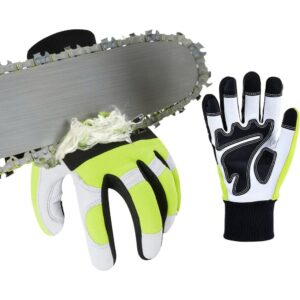Hands and Arms Protection Gear
3 DAY JULY SUPER SALE … Don’t Miss Out
Welcome to our comprehensive collection of hands and arms protection gears, where safety meets functionality
-
Sale!

Bite Proof Gloves | Animal Handling Gloves
Original price was: $149.$119Current price is: $119. -
Sale!

Waterproof Work Gloves | Chemical Resistant Gloves
Original price was: $99.$79Current price is: $79. -
Sale!

Welding Sleeves | Arm Protection Sleeves
Original price was: $99.$79Current price is: $79. -
Sale!

Chainsaw Gloves | Chainsaw Protection Glove
Original price was: $189.$149Current price is: $149.
Hands and Arms Protection Gear: Safeguarding Your Most Precious Tools
In various industries and workplaces, the hands and arms are vital for carrying out tasks efficiently and effectively. However, they are also vulnerable to a wide range of hazards, including cuts, abrasions, punctures, chemical exposure, and thermal risks. To ensure the safety and well-being of workers, the use of hands and arms protection gear is essential. In this blog post, we will explore the significance of hands and arms protection gear, different types available, key features to consider, and how it can benefit both workers and organizations. Whether you’re an employer or an employee, understanding the importance of hands and arms protection gear is crucial for creating a safe working environment and preserving the functionality of these valuable tools.
Section 1: The Importance of Hands and Arms Protection Gear
Hands and arms are involved in almost every work-related task, making them susceptible to various injuries. Injuries to these body parts can significantly impact a worker’s ability to perform tasks, decrease productivity, and lead to long-term consequences. Hands and arms protection gear plays a vital role in preventing injuries and ensuring the overall well-being of workers.
Protection gear for hands and arms, such as gloves, sleeves, and gauntlets, provide a barrier between the skin and potential hazards. They shield against cuts, punctures, abrasions, chemical exposure, extreme temperatures, and other risks commonly found in different industries. By wearing appropriate protection gear, workers minimize the chances of hand and arm injuries, enabling them to perform their duties with confidence and reducing the risk of lost productivity.
Section 2: Types of Hands and Arms Protection Gear
Hands and arms protection gear encompasses a wide range of options designed to cater to specific hazards and work requirements. Here are some common types:
-
Gloves:
- Cut-Resistant Gloves: These gloves are made from high-performance materials, such as Kevlar or Dyneema, offering protection against sharp objects and tools.
- Chemical-Resistant Gloves: Designed to withstand exposure to various chemicals, these gloves are crucial in industries dealing with hazardous substances.
- Heat-Resistant Gloves: Ideal for tasks involving high temperatures, these gloves provide insulation and protection against burns and thermal risks.
- Disposable Gloves: Widely used in industries such as healthcare and food handling, disposable gloves offer hygienic protection and prevent cross-contamination.
-
Arm Sleeves:
- Cut-Resistant Sleeves: Similar to cut-resistant gloves, these sleeves provide protection against cuts and abrasions on the arms while maintaining flexibility and mobility.
- Flame-Resistant Sleeves: Designed for tasks involving flames or sparks, these sleeves offer protection against heat and flames, reducing the risk of burns.
-
Gauntlets:
- Welding Gauntlets: Specifically designed for welding applications, these gauntlets offer heat resistance, insulation, and protection against sparks and molten metal splashes.
Section 3: Key Features and Considerations
When selecting hands and arms protection gear, several key features and considerations should be taken into account:
-
Material: The choice of material depends on the specific hazards present in the workplace. Common materials include leather, synthetic fibers, latex, nitrile, and neoprene. Each material offers different levels of protection and comfort.
-
Fit and Dexterity: Hands and arms protection gear should fit well and allow for sufficient dexterity to perform tasks effectively. Proper sizing, adjustable straps, and ergonomic designs contribute to a comfortable and secure fit.
-
Grip and Sensitivity: Depending on the nature of the tasks, gloves should provide an appropriate level of grip and tactile sensitivity. Workers need to maintain control and feel while handling tools or objects.
-
Durability and Longevity: Hands and arms protection gear should be durable enough to withstand the demands of the job. Consider factors such as abrasion resistance, tear resistance, and overall durability to ensure the gear can withstand daily use.
-
Compliance and Certification: Look for protection gear that meets industry standards and certifications, such as ANSI, EN, or ISO, ensuring they have been tested and approved for specific hazards.
Section 4: Benefits of Hands and Arms Protection Gear
Implementing and promoting the use of hands and arms protection gear in the workplace provides numerous benefits:
-
Injury Prevention: The primary purpose of hands and arms protection gear is to prevent injuries to these critical body parts. By minimizing the risk of cuts, punctures, chemical exposure, and other hazards, workers can perform their tasks safely and efficiently.
-
Compliance and Legal Obligation: Occupational health and safety regulations often require the use of hands and arms protection gear in various industries. Compliance with these regulations not only avoids penalties but also demonstrates an organization’s commitment to worker safety.
-
Productivity and Efficiency: When workers feel safe and protected, their confidence and productivity increase. Proper protection gear enables employees to focus on their tasks without the fear of injury, resulting in improved performance and overall efficiency.
-
Cost Savings: Investing in hands and arms protection gear can lead to long-term cost savings for organizations. By preventing injuries, companies can reduce medical expenses, workers’ compensation claims, and potential downtime caused by accidents.
Hands and arms are invaluable tools in the workplace, and their protection should be a top priority. By understanding the importance of hands and arms protection gear, the various types available, and the key features to consider, organizations can create a safe working environment and preserve the functionality of these essential tools. Implementing proper protection gear not only prevents injuries but also ensures compliance with regulations, enhances productivity, and contributes to cost savings. Remember, safeguarding the hands and arms of workers is not only a responsibility but also an investment in the success and well-being of both employees and organizations.

Ordering Online
Which payment methods are accepted?
We currently only accept credit card payments, PayPal & Crypto currency. More payment methods will be added in the future.
What currency are the prices displayed in?
All of our prices are displayed in $ AUD.
What are your delivery options and how long will it take?
- Australia: Free delivery, 5-7 days
OUR DELIVERY PARTNERS INCLUDE

Do I get a receipt for my order?
You will be sent a receipt for your order by email after payment is made. You will also receive a confirmation email with a tracking number once your item has been shipped.
Do you have a shop location?
We are a “online supplier”, with no physical shop or premises. In this way, we are able to pass our considerable savings directly to you.
Are your products new or second hand?
Do your products come with warranty?
Can I return my item?
We will gladly Refund or Exchange an item if:
- The item is faulty
- The item is not the same as the description or as shown or advertised
- The item does not perform as per the manufacturers intention
You may not be entitled to a Refund or Exchange if:
- You have changed your mind and no longer require the item
- You decide you cannot afford the item
- You found the item cheaper elsewhere
- The style, colour, or size is not suitable
- You were responsible for the fault
- All refund requests MUST be accompanied with an original receipt or other proof of purchase.
- Please feel free to discuss our policy with our Manager prior to purchase.
Note that measurements quoted on our website and affiliated sites and social media channels are subject to slight variances, when purchasing items measure all items to ensure they fit your space.
Product Shipping
How do I know if my order has been shipped?
Once your order is shipped, it will be marked as complete in our database and you will receive a confirmation email with a tracking number.
I haven't received my order yet! Is it lost?
If you have any concerns with your order, please contact our support team by email and they will be glad to assist you. Most emails are answered within 1 business day.
Support Team: [email protected]
